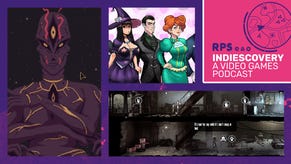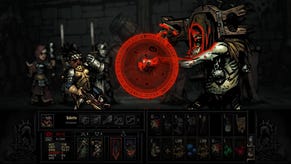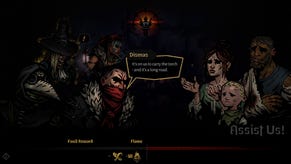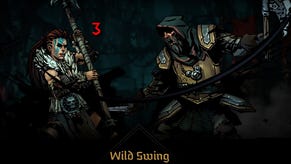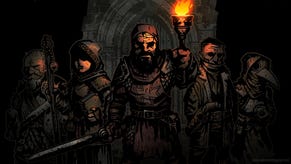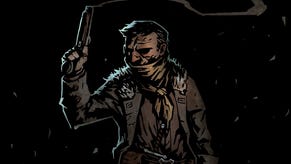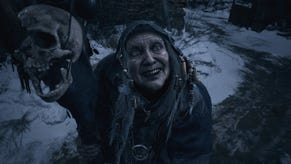There’s Beautiful Art Even In The Darkest Dungeon
Making Of
Developer Red Hook Studios’ Darkest Dungeon [official site] -- a brooding, and sadistic take on roguelike RPGs -- wouldn’t work without its gorgeous art design. Actually, it would fail miserably at everything it attempts to do otherwise, from the storytelling to the mechanics. I spoke to Darkest Dungeon's creative director Chris Bourassa to find out how they created an art style that would unify the entire game.
Art design has always been a valuable aspect of any video game. For example, Rapture in Bioshock 1 and 2 are captivating not because the games are technical powerhouses, but because they sport an aesthetic that is able to draw people in. The same goes for Dishonored; the enemy and world design are distinct and surprising, and add layers of satisfaction to the overall experience. But while great art design complements said games, it’s the focal point in Darkest Dungeon.
“The art style is crucial because at a glance, it conveys the essence of the game,” writes Bourassa when I speak to him. “Dark, somber, uncompromising, difficult, and worn - all of these things come to mind when looking at a screenshot, and are reinforced by the play experience.”
Players take control of four party members at any time, and the whole premise of the game is to challenge you with how far you can delve into a dungeon before your party members start to become both physically and mentally strained. Characters can go insane, turn on one another, and give up entirely. This is communicated through the mechanics, as character's statistics will start to wane, nullifying their ability to combat enemies.
But where the game really shines, and why it has become so beloved in the first place, is how it is able to convey the emotions the characters will inevitably feel, alongside visually showcasing the prodigious challenges that await them, through its art style. Players feel that same sense of dread and hopelessness.
“The art and design of the game were both born of a single creative vision,” Bourassa writes. “The hard edges in the art style reflect the uncompromising nature of the game, the pooling blacks are a nod to the light mechanic, and the empty eyes help convey the pervasive sense of hopelessness. Consistency is critical for immersion, so when art & design both service the creative direction of the title, players feel swallowed up in the game world.
“For instance, when characters become 'afflicted', we decided that since it was a crucial moment, we needed custom poses and new art to really sell the moment. That's an example of artwork highlighting a key feature in the game to great effect.”
The studio’s fastidious approach towards achieving this particular aesthetic makes the game feel like a living, breathing medieval painting. It’s unlike any other game out there at the moment. Bourassa had to overcome a gargantuan number of obstacles to realize their initial goal with Darkest Dungeon’s art design, especially since he is the sole artist on the team.
“We wanted the game to look and feel as though it was grounded in the time period it was describing,” he writes. “I looked at a lot of medieval woodcuts, Durer illustrations, & illuminated manuscripts. I also wanted to make sure that the game had a modern edge, so I referenced a number of my favorite comic book artists - Mignola, Davis, Bachalo, Canete. I think the biggest challenge was developing a style that would allow me to work quickly, but that would yield solid, consistent results. As the only artist, production efficiency was a big concern."
Figuring out how the art design will complement, and often dominate gameplay and storytelling was an excruciating process. The latter two aspects have to feel like they belong with Darkest Dungeon’s world, and the studio was able to figure that out. What is more interesting is that the game was funded via Kickstarter. This is Red Hook Studios’ first project, and being an unknown name meant the team had to come out swinging with its initial idea. Often times with Kickstarter, if you aren’t a big name like Keiji Inafune or Double Fine, there has to be an instant, visceral way to entice people to take interest in your project, and hopefully fund it. In this case, judging a book by its cover is an inevitability.
Darkest Dungeon’s distinct look left an everlasting impact on people when it was announced, and that seems to me to be the biggest reason why it was funded. The idea of your characters suffering mentally and giving up was an exciting and novel premise sure, but the presentation has to be equally striking. Simply put, the game wouldn’t exist in the first place without its visual style.
“I agree,” Bourassa writes. “Kickstarter is an interesting animal, because you are really marketing a promise, and as such, art and impression matter a great deal - you want to attract people to the potential that your vision has. I think there may be a temptation to research current art trends and craft your project to capitalize on what's 'hot' - pixel art, for instance, enjoyed a great deal of attention for a few years. For us, we felt it was important to stick with a style that worked well with the type of game we were making, and that was unique enough to stand out in a crowded marketplace. Instead of chasing a trend, we wanted to leapfrog the current climate and strike out on our own.”
Bourassa hails from a triple-A background and having the creative freedom to work on something like Darkest Dungeon felt liberating for him. Most triple-A publishers out there wouldn’t greenlight a project like this -- there are simply too many risks involved - and the push in the mainstream still seems to be towards photorealism. As the technology behind games continues to plateau however, delivering diminishing returns for higher polygon counts, the importance of their art styles -- and the pressures faced by their artists -- will continue to increase. Originality and creativeness could become harder to accomplish in the triple-A scene even as they become more vital.
“I can only speak for myself, but coming from AAA development, where there is indeed a great pressure to produce increasingly 'realistic' concept art, it was refreshing and invigorating to get back to something more stylized,” Bourassa writes. “It's liberating to work more quickly, and I enjoy the results, so it's a win/win. I do see a widening gulf between AAA development and smaller scale operations like ours.
“There's a higher level of risk aversion on bigger titles because of the development costs, so they tend to take fewer risks, with design and art alike, and that can feel very restrictive. If anything, the increasing popularity of 'indies' has shown that there is room in the market for all kinds of styles and interpretations -- I think that's healthy for developers and for consumers alike.”
Darkest Dungeon isn’t a triple-A game at all. Rather, it’s a mammoth risk taken by a brand new studio that ultimately paid off. Bourassa and the rest of the team’s herculean effort to differentiate itself, and offer players something truly unique to experience resulted in one of the best games to come out of Kickstarter. Its art design is front and center, demanding your attention, and opening your eyes to what videogames are capable of.







